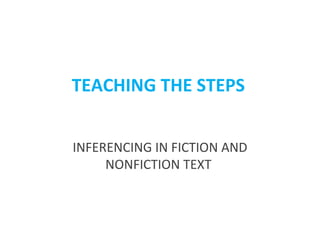Inferencing july12 slides
•Transferir como PPT, PDF•
0 gostou•2,484 visualizações
J. Michael Woody
Denunciar
Compartilhar
Denunciar
Compartilhar

Recomendados
Recomendados
Mais conteúdo relacionado
Mais procurados
Mais procurados (18)
Dean r Berry real life problems vicious dogs used as weapons

Dean r Berry real life problems vicious dogs used as weapons
Semelhante a Inferencing july12 slides
Semelhante a Inferencing july12 slides (20)
Part 1 unit 1 lesson 2 coherence transition between ideas

Part 1 unit 1 lesson 2 coherence transition between ideas
Prompt #1 Examples of Inductive InferencePrepare To prepare to.docx

Prompt #1 Examples of Inductive InferencePrepare To prepare to.docx
Standard Form ArgumentsDiscussion TitleThe central tool of.docx

Standard Form ArgumentsDiscussion TitleThe central tool of.docx
Último
Último (20)
Salient Features of India constitution especially power and functions

Salient Features of India constitution especially power and functions
UGC NET Paper 1 Mathematical Reasoning & Aptitude.pdf

UGC NET Paper 1 Mathematical Reasoning & Aptitude.pdf
Python Notes for mca i year students osmania university.docx

Python Notes for mca i year students osmania university.docx
On National Teacher Day, meet the 2024-25 Kenan Fellows

On National Teacher Day, meet the 2024-25 Kenan Fellows
This PowerPoint helps students to consider the concept of infinity.

This PowerPoint helps students to consider the concept of infinity.
ICT role in 21st century education and it's challenges.

ICT role in 21st century education and it's challenges.
Food safety_Challenges food safety laboratories_.pdf

Food safety_Challenges food safety laboratories_.pdf
Inferencing july12 slides
- 1. TEACHING THE STEPS INFERENCING IN FICTION AND NONFICTION TEXT
- 2. You make inferences in fiction about: EVIDENCE FROM THE TEXT
- 4. MAKING INFERENCES ABOUT CHARACTER • Read a small chunk: STOP • THINK • TALK/WRITE • Think about characters actions, dialogue, relationships • What is a smart guess I could make (inference) about the character • What evidence do I have to support my inference?
- 5. You make inferences in nonfiction about: EVIDENCE FROM THE TEXT
- 6. What can you inference about this photograph? (Visual Example)
- 7. What can you inference about this photograph? (Visual Example)
- 8. MAKING INFERENCES FROM FACTS • Read a small chunk of text and underline a fact that is presented • Come up with possible inferences about that fact OR • If you have problems, then think about questions the fact raises • Try to think of possible answers to your questions (these answers will be your inferences) • Think about each inference – give each one a rating (see below) • Choose the inferences that have a 3 or 4 rating (these are the best ones) • Keep reading the text and underline evidence that supports your inference 1 = Not Likely 2 = Possibly 3 = Very Likely 4 = Almost Certain
- 9. MAKING INFERENCES FROM FACTS FACTS: deal with pieces of information that one has heard, seen or read, and which are open to discovery or verification. The key word here is “verification”. A fact is a statement that can be ‘verified’. A fact is either true or false. Facts are statements that may involve numbers, natural phenomena, dates etc. The characteristics of the statements classified as facts are: • Made after observation or experience. An event cannot become a fact unless it has occurred. • Confined to what one observes; cannot be made about the future. • Limited number possible. • Not perception dependent. A fact will be agreed to by every person. It does not change from person to person. • Tends to bring people together in agreement.
- 10. Example 1: FACT A football field is 100 yards long.
- 11. Example 2: FACT This oil spill has now obtained the dubious distinction of being the worst oil spill in US history, surpassing the damage done by the Exxon Valdez tanker that spilled 11 million gallons of oil into the ecologically sensitive Prince William Sound in 1989.
- 12. EXAMPLE: NONFICTION Think about the fact presented Come up with possible inferences If you have problems, then think about questions the fact raises Try to think of possible answers to your questions These will be your inferences Think about each inference – give each one a rating Choose the inferences that have a 3 or 4 rating What evidence from the text can support your answer? 1 = Not Likely 2 = Possibly 3 = Very Likely 4 = Almost Certain